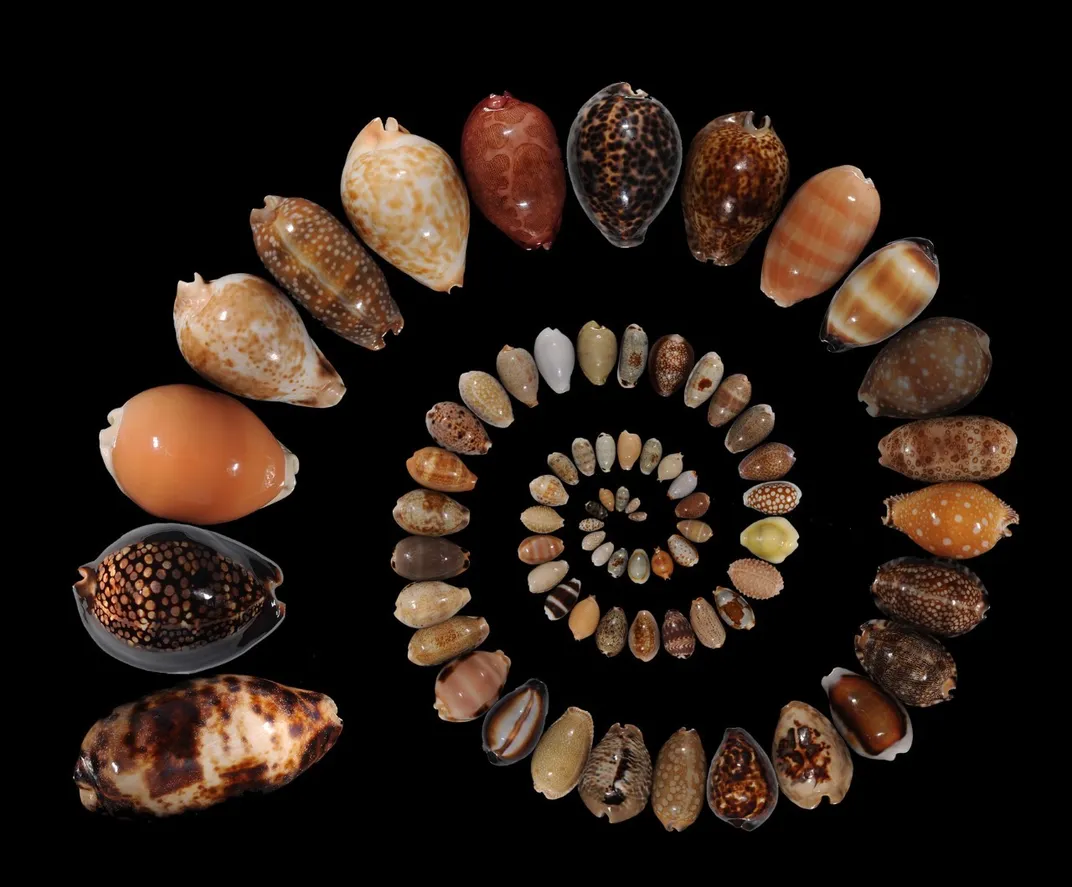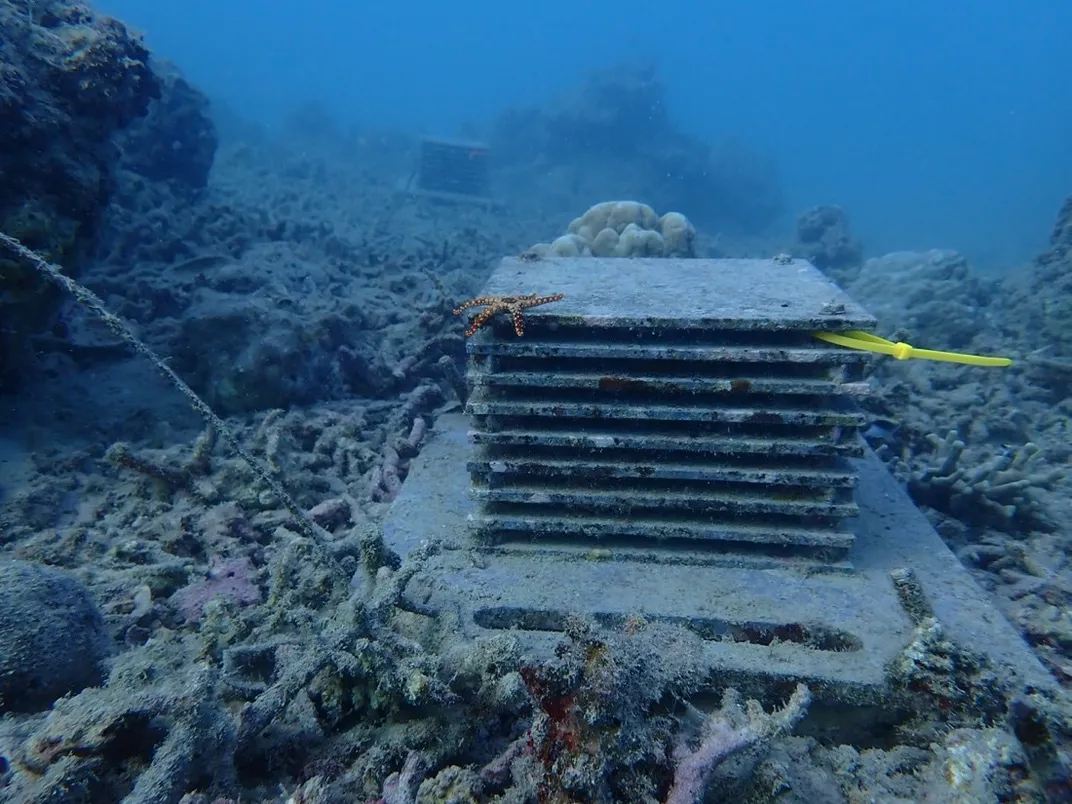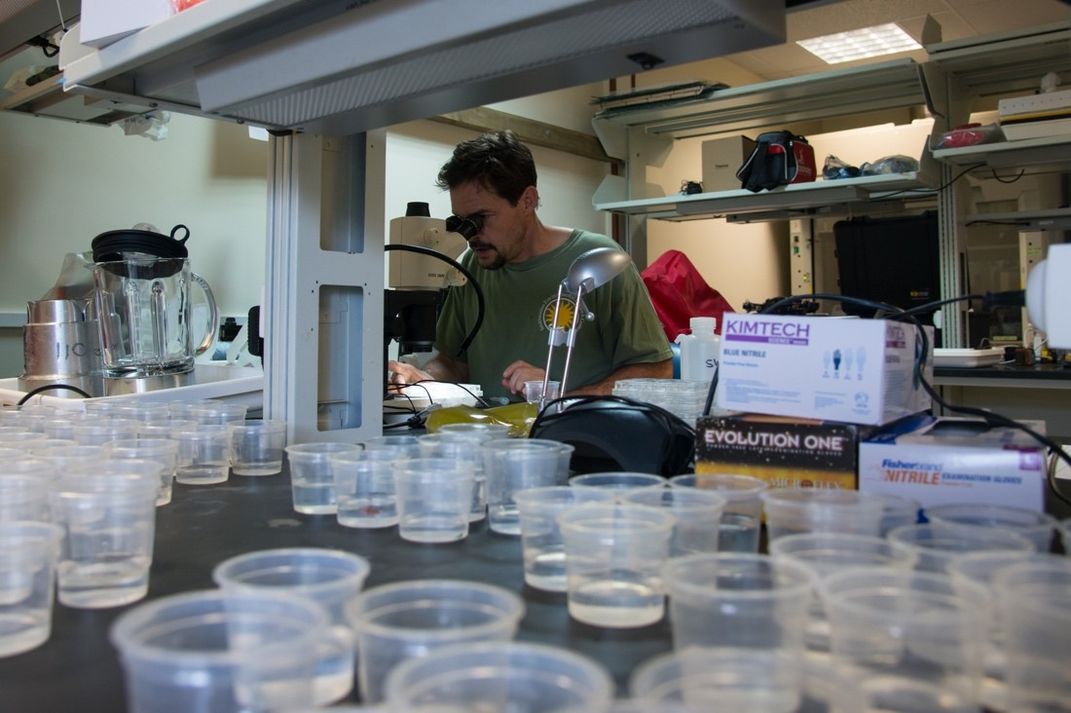NATIONAL MUSEUM OF NATURAL HISTORY
Meet the Reef Expert Collecting Environmental Time Capsules
Collecting DNA in waters worldwide can help scientists figure out which places are the most important for conservation.
/https://tf-cmsv2-smithsonianmag-media.s3.amazonaws.com/blogging/featured/Diver_placing_a_yellow_crate_upside_down_on_a_reef.jpg)
As summer tightens its grip, there’s one thing to look forward to: vacation. But one person’s tropical island getaway can sometimes be another person’s fieldwork location.
In this “Meet a SI-entist," Chris Meyer, invertebrate zoologist and curator of mollusks at the Smithsonian’s National Museum of Natural History, shares what a typical day of fieldwork in the tropics looks like and explains how marine DNA “dust” can revolutionize biodiversity research.
What led to you to study mollusks like clams, mussels, and sea snails?
As a kid, I collected everything — even sand from different beaches. So, I always had a collector's gene growing up. But in college, I had a really hard time with biology until I started learning about paleontology in the geology department, which is where everything clicked. Seeing how change throughout time was a common thread with evolution suddenly made sense. It started me down the path of asking research questions like why and how.
I was fortunate to have a lot of professors who nurtured my interests. One suggested I do a fellowship studying why cowrie shells are colored the way they are. I chose these shells because they’re made by a very diverse set of sea snails usually found in the tropics. They’re also one of the first natural objects people collected. This research led me to many island communities throughout the Indo Pacific where I met people who were as passionate about collecting as I was. No matter where I went, I could always find a shell collector who knew where to find cowries.

During my doctorate, I wanted to build a family tree of the cowries to better understand how their diversity evolved. But I needed DNA from the cowries, not just their shells. Everyone told me it was going to be too difficult to collect that DNA from that many species, but I managed to do it. In doing so, I realized if we can inventory DNA all the cowries, we can do it for everything. It snowballed from there basically.
What does a typical day of inventorying marine life look like?
Right now, the big project I'm leading is the Global Autonomous Reef Monitoring Structures (ARMS) Program. We’re placing removable PVC stacks on the sea floor, where they stand like little weather stations. We pick them back up after they've collected the “flavor” of the site. ARMS are biological monitors for the environment.

As the sun goes up, we usually head out on the water where we dive for an hour or so to recover ARMS at each site. After that, we bring them back to shore, where we identify, or characterize, all the animals and organisms that have moved in.
It’s a long, involved process because we want to document diversity, but we don’t want to over collect. We’re conscious about taking only what we need and returning the creatures we don’t use to the places where we got them.
The goal is to create a standard way to monitor change throughout time in marine communities that are otherwise hard to measure. To do so, we’re taking representative DNA samples of all the species and creating a Rosetta Stone to translate genetic sequences into species names and build biodiversity knowledge.
One of the other things you’re working on is called environmental DNA, or eDNA. What is eDNA and why is it useful to study?
One of the ways I explain eDNA is that it’s like dust. Most of the dust in your house, or environment, is shed by creatures including you. All the creatures in the water are doing that too with DNA. We can filter that water and analyze the DNA to determine species that were around at the time the sample was taken — all without directly interfering with the animals. We can also archive the samples as time capsules of all the DNA in an environment, giving the next generation of stewards and scientists the ability to examine biodiversity in both the present and the past as new tools or questions emerge.
But different species have different shedding rates, so we need to figure out how those rates affect our results. There's also good science being done on how quickly DNA degrades based on temperature and ultraviolet light exposure. We are getting better at understanding exactly what we can infer when it comes to how DNA gets into, how it moves around, and how long it lasts in the environment.

In general, we have to standardize how we monitor these ecosystems with eDNA. We want to find ways to sample eDNA signals that are sensitive to change, and we want to be able to compare results across space and time.
How does eDNA sampling fit into the Natural History museum’s collections?
Well, to me it’s about unlocking the National Museum of Natural History’s collection in new ways and expanding its uses. By sequencing the collections, we can provide a key to all knowledge about a species. If we’re strategic about how and where we collect now, our collections will become critical anchor points for evaluating species change in the future.
That's why the Smithsonian’s new Ocean DNA Initiative is so exciting. This program is drawing different threads of the museum together for a common cause: using DNA to track changes in marine communities. We’re working to record all the diversity in US waters and beyond. We can then use those assessments to figure out which places are the most important for conservation and see how climate change is impacting different species.
I can’t think of a better time to do biodiversity science than right now. If we do this right, our library will last for centuries and be used by all future generations.
Meet a SI-entist: The Smithsonian is so much more than its world-renowned exhibits and artifacts. It is a hub of scientific exploration for hundreds of researchers from around the world. Once a month, we’ll introduce you to a Smithsonian Institution scientist (or SI-entist) and the fascinating work they do behind the scenes at the National Museum of Natural History.
Related Stories:
Live Jellyfish Make Splash in Marine Education
DNA Makes Waves in the Fight to Save Coral Reefs
Why Fishes are the Catch of the Day for Climate Research
Scientists Find Blue-Green Algae Chemical with Cancer Fighting Potential
How Scientists Learn What Lives in the Deep Ocean

